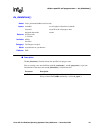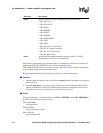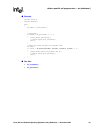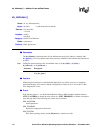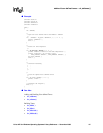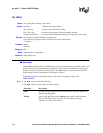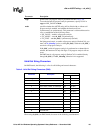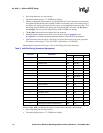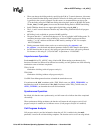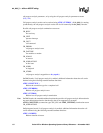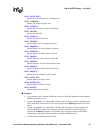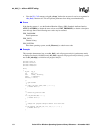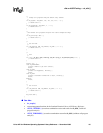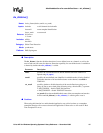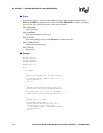
Voice API for Windows Operating Systems Library Reference — November 2003 191
dial an ASCIIZ string — dx_dial( )
• When you change the dialing mode by specifying the P, M, or T control characters, it becomes
the new default and that dialing mode remains in effect for all dialing until a new dialing mode
is specified or the system is restarted. For this reason, we recommend that you always put
“T”in the dialing string for DTMF tone dialing after using the P (pulse) or M (MF) dial modes.
The dx_close( ) and dx_open( ) do not reset the default dialing mode to DTMF tone dialing.
• Intel® TDM bus boards do not support pulse digit dialing using dx_dial( ).
• The L, I, and X control characters function only when dialing with PerfectCall call progress
analysis.
• MF dialing is only available on systems with MF capability.
• The pause character “,” and the flash character “&” are not available in MF dialing mode. To
send these characters with a string of MF digits, switch to DTMF or pulse mode before
sending “,” or “&”, and then switch back to MF mode by sending an “M”. For example:
M*1234T,M5678a
• Dialing parameter default values can be set or retrieved using dx_getparm( ) and
dx_setparm( ); see the board and channel parameter defines in these function descriptions.
• Invalid characters that are part of a dial string are ignored and an error will not be generated.
For instance, a dial string of “(123) 456-7890” is equivalent to “1234567890”.
Asynchronous Operation
Set the mode field to EV_ASYNC, using a bitwise OR. When running asynchronously, the
function will return 0 to indicate it has initiated successfully, and will generate one of the following
termination events to indicate completion:
TDX_CALLP
termination of dialing (with call progress analysis)
TDX_DIAL
termination of dialing (without call progress analysis)
Use SRL Event Management functions to handle the termination event.
If asynchronous dx_dial( ) terminates with a TDX_DIAL event, use ATDX_TERMMSK( ) to
determine the reason for termination. If dx_dial( ) terminates with a TDX_CALLP event, use
ATDX_CPTERM( ) to determine the reason for termination.
Synchronous Operation
By default, this function runs synchronously, and will return a 0 to indicate that it has completed
successfully.
When synchronous dialing terminates, the function will return the call progress result (if call
progress analysis is enabled) or 0 to indicate success (if call progress analysis isn’t enabled).
Call Progress Analysis
Call progress analysis provides information about the call. If it is enabled using the mode
parameter, it runs on the call after dialing completes. The function can be set to run using default



